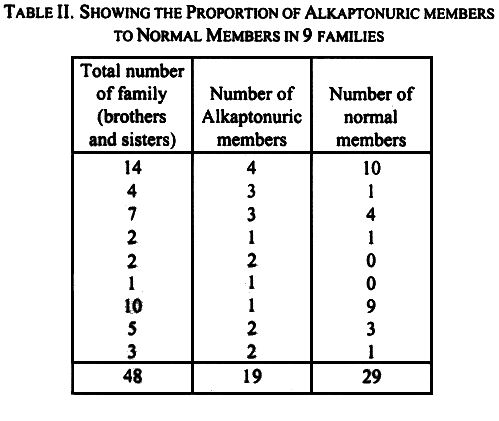
Ascertainment
bias is a systematic distortion in measuring the true
frequency of a phenomenon due to the way in which the data are
collected. In genetics, ascertainment bias is an important factor
in the use of family pedigree data to establish modes of
inheritance.
Consider the
inheritance of the genetic condition Alkaptonuria,
characterized by excretion of high amounts of "alkapton" (Homogentisic Acid) in the
urine. Alkaptonuria is an autosomal
recessive trait, such that almost all persons born
with the condition (aa) will be the offspring of two
unaffected heterozygous carrier (Aa) parents. Thus,
according to ordinary Mendelian principles, among a large group of
Aa x Aa crosses, 1/4
of offspring are expected to show the condition. Recognition of
the 3:1 ratio would be an important clue to the pattern of
inheritance.
Alkaptonuria was the first human medical trait to be identified as genetic. In the first inquiry into the genetics of this condition, Garrod (1902) reported the following data:

Given the birth of
alkaptonuric offspring with (aa) to unaffected "normal" parents, the parents
must all be carriers (Aa). Then, among a total of 48 offspring
of such parents, the expected ratio
should be 1:3 or 12 alkaptonuric : 36
normal members. The observed ratio
is 19 : 29, significantly
more alkaptonurics are present in the sample than expected from
the genetic model. Why is this? The answer is the way in which
Garrod collected his data, which results in ascertainment
bias.
One source of ascertainment bias is that Garrod as a physician saw people who consulted him medically. His data tables includes only families in which at least one child has alkaptonuria. Because there is a 3/4 chance that any single child born to Aa parents will not have alkaptonuria, they will not consult Garrod, and he will not count this "zero class". The same is true for (3/4)2 = 9/16 and (3/4)3 = 27/64 of two- & three-child families. Thus, large numbers of families with two Aa parents and 1, 2, 3, or more unaffected children are excluded from his counts, and are underrepresented in his counts.
A second source is the greater likelihood that families with a higher number of alkaptonuric children will consult Garrod: they are more likely to seek advice than families in which the condition occurs only a single child. In the table, 6 of 9 families reported have more than one affected child, and in all of these (except family #7) the observed ratio of affected children exceeds 1:3. Indeed, without family #7, the observed proportion would be 18:20, effectively 1:1, which would support a model of autosomal dominant inheritance in which Aa x aa => 50% Aa: 50% aa. Ascertainment bias skews the data towards a higher number of affected children.
A classroom demonstration of
ascertainment bias is a survey for the primary sex ratio in humans.
Homework: (1) Test the deviation
between the observed and expected results by
the Chi-Square
test.
(2) Suggest some methods to correct Garrod's data to test
the hypothesis of recessive inheritance.